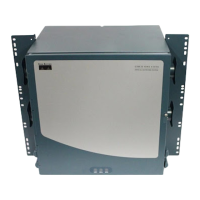5-5
Cisco ONS 15454 Procedure Guide, R5.0
December 2004
Chapter 5 Turn Up Network
NTP-A173 Point-to-Point Network Acceptance Test
Step 3 Click the Alarms tab.
a. Verify that the alarm filter is not on. See the “DLP-A227 Disable Alarm Filtering” task on
page 19-17 as necessary.
b. Verify that no unexplained alarms appear on the network. If unexplained alarms appear, resolve
them before continuing. Refer to the Cisco ONS 15454 Troubleshooting Guide if necessary.
c. Complete the “DLP-A516 Export CTC Data” task on page 22-6 to export alarm data.
Step 4 Click the Conditions tab.
a. Verify that no unexplained conditions appear on the network. If unexplained conditions appear,
resolve them before continuing. Refer to the Cisco ONS 15454 Troubleshooting Guide if necessary.
b. Complete the “DLP-A516 Export CTC Data” task on page 22-6 to export the condition information.
Step 5 On the network map, double-click a point-to-point node to open it in node view.
Step 6 Create a test circuit from the login node to the other point-to-point node:
• For DS-1 circuits, complete the “NTP-A181 Create an Automatically Routed DS-1 Circuit”
procedure on page 6-6. When you set the circuit state, choose IS and check the Apply to drop ports
check box.
• For DS-3 circuits, complete the “NTP-A184 Create an Automatically Routed DS-3 Circuit”
procedure on page 6-18. When you set the circuit state, choose IS and check the Apply to drop
ports check box.
• For OC-N circuits, complete the “NTP-A257 Create an Automatically Routed OC-N Circuit”
procedure on page 6-38. When you set the circuit state, choose IS and check the Apply to drop
ports check box.
Step 7 Configure the test set for the test circuit type you created:
• DS-1—If you are testing a DS-1 that is not multiplexed, you must have a DSX-1 panel or a direct
DS-1 interface to the ONS 15454. Set the test set for DS-1. For information about configuring your
test set, consult your test set user guide.
• DS-3—If you are testing a clear channel DS-3, you must have a DSX-3 panel or a direct DS-3
interface to the ONS 15454. Set the test set for clear channel DS-3. For information about
configuring your test set, consult your test set user guide.
• DS3XM-6 or DS3XM-12—If you are testing a DS-1 circuit on a DS3XM-6 or DS3XM-12 card you
must have a DSX-3 panel or a direct DS-3 interface to the ONS 15454. Set the test set for a
multiplexed DS-3. Next, choose the DS-1 to test on the multiplexed DS-3. For information about
configuring your test set, consult your test set user guide.
• OC-N—If you are testing an OC-N circuit, set the test set for the applicable circuit size. For
information about configuring your test set, consult your test set user guide.
Step 8 Verify the integrity of all patch cables that will be used in this test by connecting one end to the test set
transmit (Tx) connector the other to the test set receive (Rx) connector. If the test set does not run
error-free, check the cable for damage and check the test set to make sure it is set up correctly before
going to Step 9.
Step 9 Create a physical loopback at the circuit destination card. To do so, attach one end of a patch cable to
the destination port’s Tx connector; attach the other end to the port’s Rx connector.
Step 10 At the circuit source card:
a. Connect the Tx connector of the test set to the Rx connector on the circuit source card.
b. Connect the test set Rx connector to the circuit Tx connector on the circuit source card.

